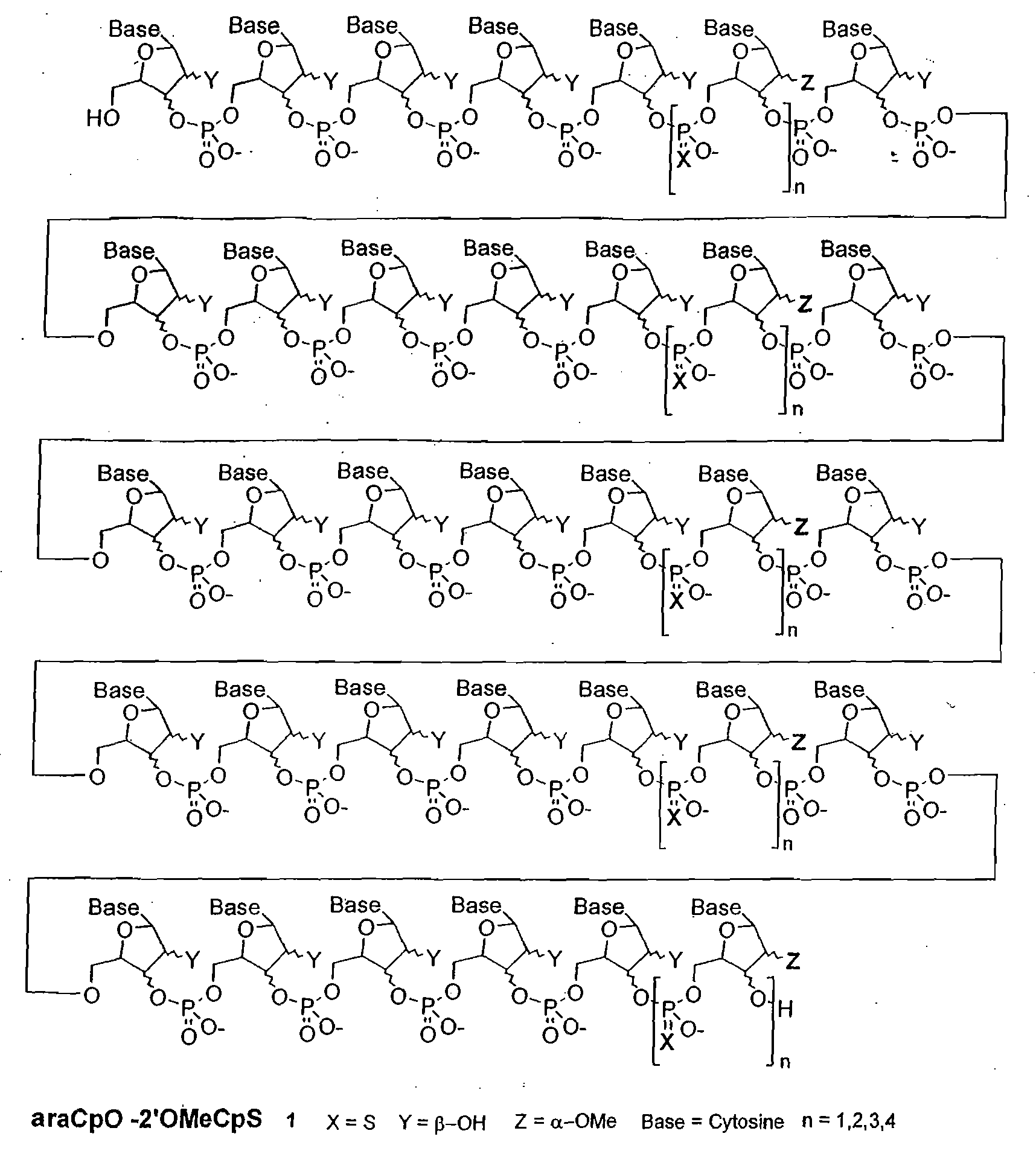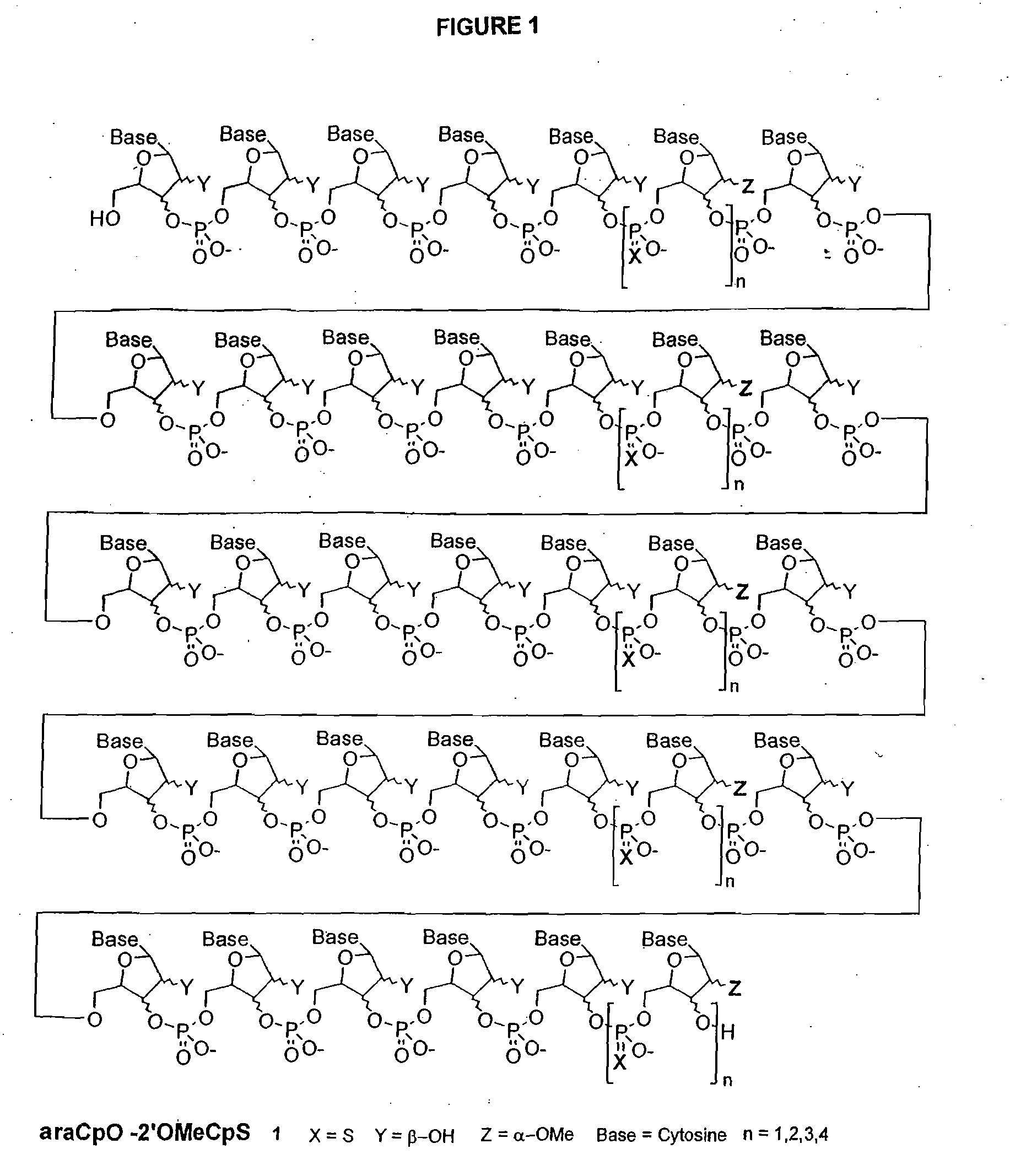Polymeric nucleoside prodrugs
a nucleoside and polymer technology, applied in the field of polymer compounds, can solve the problems of increasing the overall cost of the therapy for the patient, and inconvenient patient's daily activities
- Summary
- Abstract
- Description
- Claims
- Application Information
AI Technical Summary
Benefits of technology
Problems solved by technology
Method used
Image
Examples
example 1
Synthesis of Protected-Anhydrouridine 3
[0123]The 2,2′-anhydrouridine, 2 (87 g, 0.385 mol, 1.0 eq) was coevaporated with pyridine (2×500 mL). The residue was suspended in pyridine (3000 mL) and to it was added 4-dimethylaminopyridine (DMAP, 4.7 g, 38.5 mmol, 0.1 eq) and dimethoxytrityl chloride (DMT-Cl, 156 g, 0.46 mole, 1.2 eq). The reaction mixture was stirred for 6 h at room temperature. Thin layer chromatography (TLC, SiO2, 3:7 MeOH:EtOAc) monitoring showed complete reaction. The reaction mixture was quenched with methanol (MeOH, 80 mL) and then evaporated to remove pyridine. The residue was coevaporated with toluene and the residue dissolved with ethyl acetate (EtOAc) and extracted with water. The extract was concentrated and the crude product purified by flash silica gel column chromatography to give the 5′-DMT-2,2′-anhydrocytidine (106 g, 52%). The product identity was confirmed by 1H NMR (300 MHz, DMSO-d6, δ ppm) 7.95 (1H, d, J=7.5), 7.2 (9H, m), 6.8 (4H, m), 6.32 (1H, d, J=5...
example 2
Synthesis of Protected-Arabinouridine 4
[0125]The anhydro moiety of the intermediate, 3 was opened by reaction with triethylamine. The 5′-DMT-3′-TBDMS-2,2′-anhydrouridine, 3 (140 g, 218 mmol) was dissolved in acetonitrile (ACN, 500 mL) and to it was added triethylamine (250 mL) and aqueous sodium hydroxide (NaOH, 0.25 M, 250 mL). The reaction mixture was stirred for 16 h at room temperature. TLC (SiO2, 1:9 MeOH:EtOAc) monitoring showed complete reaction. The reaction mixture was evaporated, extracted with EtOAc and the extract was dried and evaporated. The crude concentrate was purified by flash silica gel chromatography with 2:8 Hexanes:EtOAc, then EtOAc to elute the product. The fractions were concentrated to give pure 5′-DMT-3′-TBDMS-2′-arabinouridine as a yellow solid (100 g, 69.5%). The product identity was confirmed by 1H NMR (300 MHz, DMSO-d6, δ ppm) 11.39 (1H, d, J=2.2, NH), 7.61 (1H, d), 7.4 (9H, m), 6.95 (4H, m), 6.11 (1H, d, J=5), 5.81 (1H, d, J=5), 5.43 (1H, dd, J=8, 2.2)...
example 3
Synthesis of Protected-Arabinocytidine 5
[0127]The fully protected ara-U, 4 is then aminated by a two-step process, triazolide formation and amination. The amination with ammonium hydroxide simultaneous deprotects the 2′-acetylyl to give 5. The 5′-DMT-3′-TBDMS-2′acetyl-2′-arabinouridinc, 4, (45 g, 64 mmol) was dissolved in acetonitrile (1500 mL) and to it were added 1,2,4-Triazole (72 g, 1.02 mol, 16 eq.) and triethylamine (143.3 mL, 103.2 g, 1.02 mol, 16 eq). To the reaction mixture cooled to 0° C. was added POCl3 (24 mL, 39.3 g, 256 mmol, 4 eq) dropwise. After the addition was complete the reaction was stirred at room temperature until no starting material was observed by TLC (SiO2, 2:3 Hexanes:EtOAc). The reaction mixture was filtered, washed with acetonitrile (1000 mL) and poured into a 2 gallon Parr reactor. To this was added concentrated ammonium hydroxide (500 mL), sealed and heated to 50° C. for 5 hours. After the reaction was cooled to room temperature, the acetonitrile was ...
PUM
| Property | Measurement | Unit |
|---|---|---|
| temperature | aaaaa | aaaaa |
| length | aaaaa | aaaaa |
| length | aaaaa | aaaaa |
Abstract
Description
Claims
Application Information
 Login to View More
Login to View More - R&D
- Intellectual Property
- Life Sciences
- Materials
- Tech Scout
- Unparalleled Data Quality
- Higher Quality Content
- 60% Fewer Hallucinations
Browse by: Latest US Patents, China's latest patents, Technical Efficacy Thesaurus, Application Domain, Technology Topic, Popular Technical Reports.
© 2025 PatSnap. All rights reserved.Legal|Privacy policy|Modern Slavery Act Transparency Statement|Sitemap|About US| Contact US: help@patsnap.com



